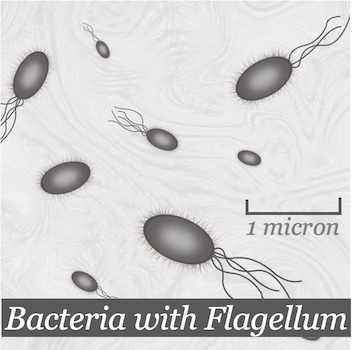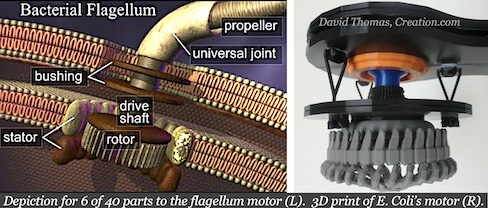 We move deeper in the book of DNA’s blueprints for all of life to some of its more exotic chapters. Recall that DNA specifies the machines used to read and build what it encodes. That’s like a DVD with instructions on how to write a DVD and build a DVD player. Personally, I find DNA’s most fascinating specs are for molecular machines. In fact, you have up to 40 different types of them. They enable bodily functions such as coagulation, immune response, ATP synthase, and oxygen transport. [1] Consider one simple example called the bacterial flagellum (Latin, flagella, meaning whip; see picture, right).
We move deeper in the book of DNA’s blueprints for all of life to some of its more exotic chapters. Recall that DNA specifies the machines used to read and build what it encodes. That’s like a DVD with instructions on how to write a DVD and build a DVD player. Personally, I find DNA’s most fascinating specs are for molecular machines. In fact, you have up to 40 different types of them. They enable bodily functions such as coagulation, immune response, ATP synthase, and oxygen transport. [1] Consider one simple example called the bacterial flagellum (Latin, flagella, meaning whip; see picture, right).
Tesla would be envious to have this inboard-outboard motor. It’s powered by the flow of hydrogen protons, not electrons, from the oxidation of food. It can quickly stop, start, change speeds and direction within a quarter turn. Topping out at 100,000 RPM, the germ propels forward to 15 body lengths per second; this is like 6-foot person swimming 60 miles an hour. Man-made electric motors achieve 75-95% efficiency when built large enough, but quickly lose efficiency when miniaturized. The 25 nanometer (millionth of an inch) bacterial flagellum is 100% efficient at cruising speed, and only uses 2% of its energy to swim. [2] Human attempts to reduce to tinier sizes encounter problems with friction as water gets sticky at that scale, but no issues here. Engineers have never built a motor of any type as rapid, efficient, and small as the bacterial flagellum; in fact, what we have is primitive and clunky by comparison. All the factories to build this machine reside (and are built, per DNA specs) inside the bacterium.
Its parts list sounds familiar. In addition to the propeller (flagellar whip) which generates waves for propulsion, it has a U-joint, bushings, axle, drive shaft, powered gears, rotor, central gears, and a proton fuel pump (see depiction and photo, right). It operates a clutch, allowing it to disengage quickly without destroying the motor. This is a big problem for engineers, because once you start it turning, how do you quickly stop without breaking something? This clutch utilizes a single protein, which takes under 15 minutes to make.[3] Some motors have high and low gears. One germ has seven of these bad boys in a bundle, enabling it to swim 10 times faster. Its seven whips work independently or together. They are bound in a sheath connected by a hexagonal pattern of gears for smooth, tangle free operation. [4] What an amazing engine and transmission for a lowly bacterium!
Dr. Michael Behe in his book, Darwin’s Black Box, described a principle known as Irreducible Complexity, which argues some components are impossible to evolve one step at a time without all the pieces present at once; e.g., five mouse trap parts must exist and connect before a mouse is caught. The simplest bacterial motor needs 40 parts, just 10 of which are found in other non-motor biological components – so it couldn’t “co-opt parts” from other existing sources. Darwin wrote in The Origin of Species, “If it could be demonstrated that any complex organ existed which could not possibly have been formed by numerous, successive slight modifications, my theory would absolutely break down.” [5] In the 1940’s, evolutionist J.B.S. Haldane predicted we would find no wheels (or magnets) in living creatures, as these wouldn’t work unless fully formed. Finding a submersible electric engine with high-performance parts inside puny bacteria blasts a massive hole in Darwin’s theory. Our God doeth great things past finding out; yea, and wonders without number.
[1] List of 40 molecular machines: https://evolutionnews.org/i/molecular-machines/
[2] Steven DeVowe, Creation.com, The amazing motorized germ, Dec. 2004.
[3] Dr. J. Sarfati, Creation.com, Germ’s miniature motor has a clutch, Dec. 2008.
[4] Dr. Jonathan Sarfati, Creation.com, Germ with seven motors in one, Jan. 2013.
[5] Illustra Media video, The Evidence of Biological Machines, accessed at John 10:10 project. This site has an excellent 9-minute “must watch” video.
Like this? Consider sharing it to Facebook by clicking the linked icon below.
